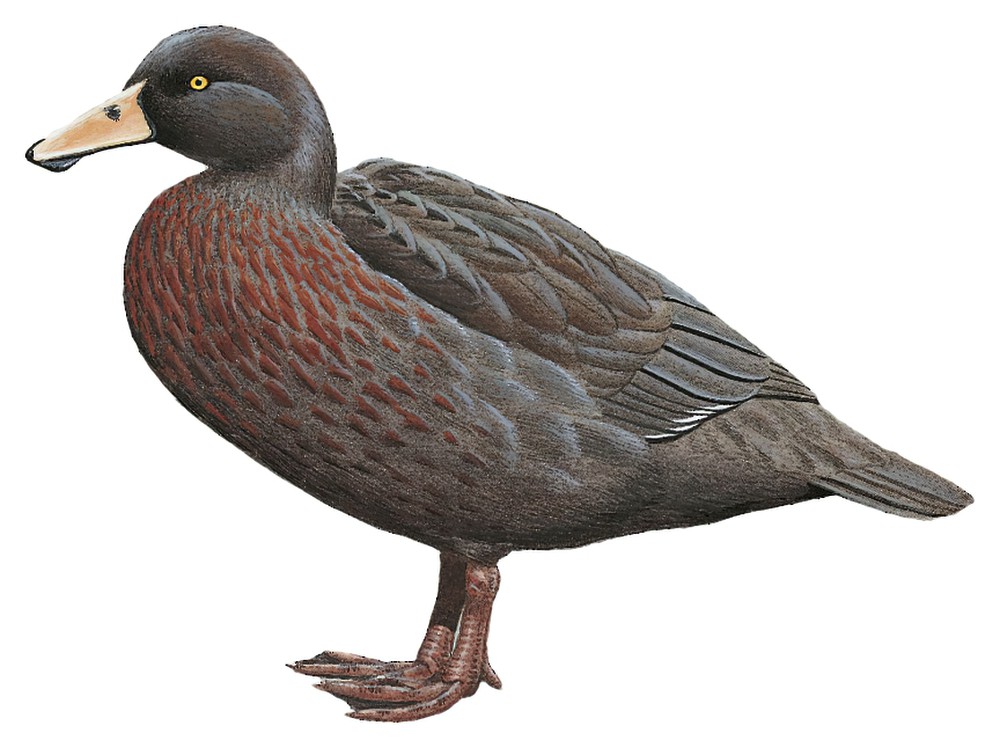Blue Duck / Hymenolaimus malacorhynchos

Blue Duck
SCI Name:
Protonym: Anas malacorhynchos Syst.Nat. 1 pt2 p.526
Taxonomy: Anseriformes / Anatidae / Hymenolaimus
Taxonomy Code: bluduc1
Type Locality: Dusky Sound, South Island, New Zealand.
Author: Gmelin, JF
Publish Year: 1789
IUCN Status: Endangered
DEFINITIONS
HYMENOLAIMUS
(Anatidae; Ϯ Blue Duck H. malacorhynchos) Gr. ὑμην humēn, ὑμενος humenos membrane; λαιμος laimos throat; although all early descriptions (e.g. Cook, Latham, Gmelin) refer to the soft bill of this duck, none allude to the membraneous upper chin; "AMONG the ducks described by Latham in his 'Synopsis' is one that he denominated the Soft-billed Duck ... Gmelin was the first to give a scientific name, which he did by translating Latham's, as Anas malacorhynchus ... The Australian soft-billed duck is the type of the genus Malacorhynchus as established by Mr Swainson in 1831. In 1832 Wagler used the same generic name, being unacquainted with the fact that it had been previously employed: he seems to consider the New Zealand bird as the type, but mentioned the Australian one as the second species. This leaves us to conclude that Mr Swainson's genus Malacorhynchus must, by the law of priority, be retained for the Australian Anas membranacea, while a new generic name should be proposed for the New Zealand Anas malacorhynchus ... HYMENOLAIMUS." (G. Gray 1843); "Hymenolaimus G. R. Gray, Ann. and Mag. Nat. Hist., 11, 1843, p. 370. Type, by monotypy, Anas malacorhynchos Gmelin." (Peters, 1931, I, p. 183).
hymenolaimus
Gr. ὑμην humēn, ὑμηνος humēnos membrane; λαιμος laimos throat (cf. genus Hymenolaimus G. Gray 1843, blue duck).
malacorhynchos
Gr. μαλακος malakos soft; ῥυγχος rhunkhos bill; ex “Blue-grey Duck with a soft bill” of Cook 1777, and “Soft-billed Duck” of Latham 1785 (Hymenolaimus).
MALACORHYNCHUS
(Anatidae; Ϯ Pink-eared Duck M. membranaceus) Gr. μαλακος malakos soft; ῥυγχος rhunkhos bill; "The geographic distribution, then, of the true Shovellers may be termed universal. But among these broad-billed Ducks of the southern hemisphere, we find a very remarkable modification of form; the breadth of the bill and the length of the laminæ are nearly the same, but the edge of the upper mandible, instead of being smooth, as in the European species, is furnished with a thin membranaceous skin, which considerably projects, and hangs down somewhat like a wattle on each side. For this form, hitherto uncharacterised, I now propose the name of MALACORHYNCHUS, and I shall view it, for reasons hereafter stated, as a sub-genus. The bill of the European Shoveller is flexible; but in this group it is much more so." (Swainson 1831); "Malacorhynchus Swainson, Journ. Roy. Inst. Gr. Brit., 2, pt. 4, 1831, p. 18. Type, by monotypy, Anas membranacea Latham." (Peters 1931, I, 170).
Var. Malacorynchus.
● (syn. Hymenolaimus Ϯ Blue Duck H. malacorhynchos) Specific name Anas malacorhynchos J. Gmelin, 1789; "Genus Malacorhynchus Wagl., Tastlöffelente. Der Schnabel an seinem vordern erweiterten Ende seitlich mit einer schlappen, hängenden, empfindlichen Haut usw. Species: 1. M. Forsterorum (An. malacorhynchus Forst. in manuscr. et Auctor. Illius icon. inedit. tab. 74." (Wagler 1832). Var. Malacorhynchos.
● (syn. Merulaxis Ϯ Slaty Bristlefront M. ater) "VI. MALACORHYNCHUS, mihi. μαλακος mollis, ῥυγχος rostrum. MYIOTHERA, Lichtenstein, P. Max. BEC de moyenne longueur, faible, aussi haut que large à sa base, légèrement carèné en-dessus, faiblement fléchi à son extrémité, où l'on remarque une échancrure peu profonde; la mandibule inférieure est presque droite, relevée insensiblement vers la pointe. NARINES, recouvertes par une écaille cornée, formant bourrelet à l'ouverture ... 43. MALACORHYNCHUS CRISTATELLUS, mihi" (Ménétriés 1835).
UPPERCASE: current genus
Uppercase first letter: generic synonym
● and ● See: generic homonyms
lowercase: species and subspecies
●: early names, variants, mispellings
‡: extinct
†: type species
Gr.: ancient Greek
L.: Latin
<: derived from
syn: synonym of
/: separates historical and modern geographic names
ex: based on
TL: type locality
OD: original diagnosis (genus) or original description (species)












